Curious to know which animals have a taste for moss? Well, you’re in for a treat as we embark on a journey to uncover the moss-eating habits of various creatures.
From the nimble pika to the resilient caribou, there are several species that rely on moss as a crucial part of their diet. But it doesn’t end there. Snails, shrimps, and even some surprising animals have developed a fondness for this humble plant.
So, brace yourself as we uncover the moss-munching secrets of these remarkable creatures and unveil the fascinating role that moss plays in their survival.
Pikas: Mountain-Dwelling Moss Eaters
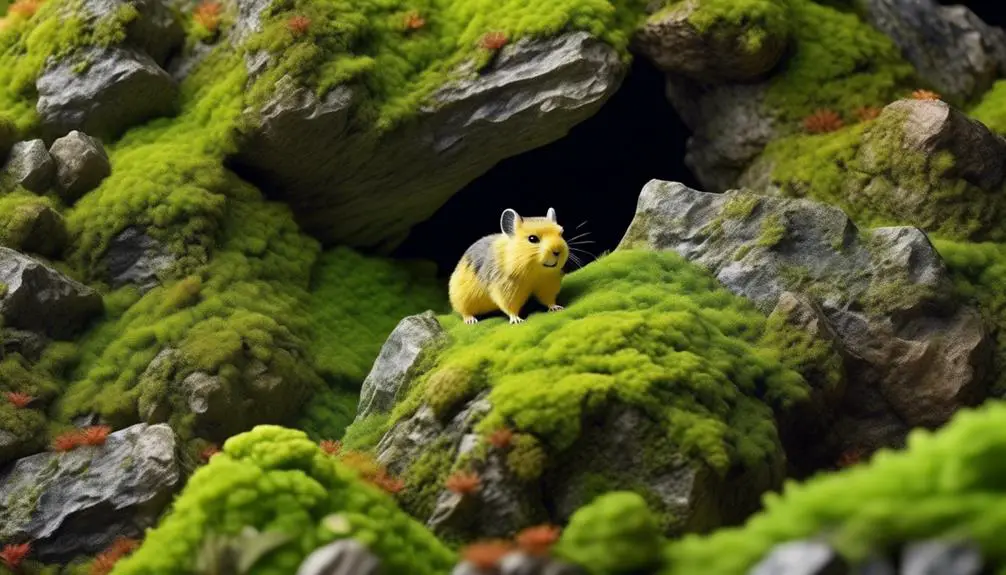
Pikas, small mountain-dwelling mammals, survive in the harsh conditions of higher reaches of the mountain by relying on a diet that consists primarily of moss and similar small plants. These creatures, distinguished by their short limbs, fur coat, and lack of tails, are found in the alpine regions. Moss accounts for a significant sixty percent of their diet, enabling them to thrive in their habitat.
Pikas are highly adapted to their environment, where temperatures can plummet and food sources are limited. They’ve developed a specialized digestive system that allows them to efficiently extract nutrients from moss. Their teeth are well-suited for grinding down the tough plant material, while their digestive enzymes break down the cellulose present in moss. This unique adaptation allows them to extract maximum energy from their diet.
Observations of pikas in their natural habitat reveal their resourcefulness in locating and consuming moss. They actively forage for patches of moss, using their keen sense of smell to detect the presence of these plants. Once found, they nibble on the delicate parts of the moss, consuming both the leaves and stems. This methodical feeding behavior ensures their survival in the challenging alpine environment.
Snails: Moss-Loving Tank Dwellers
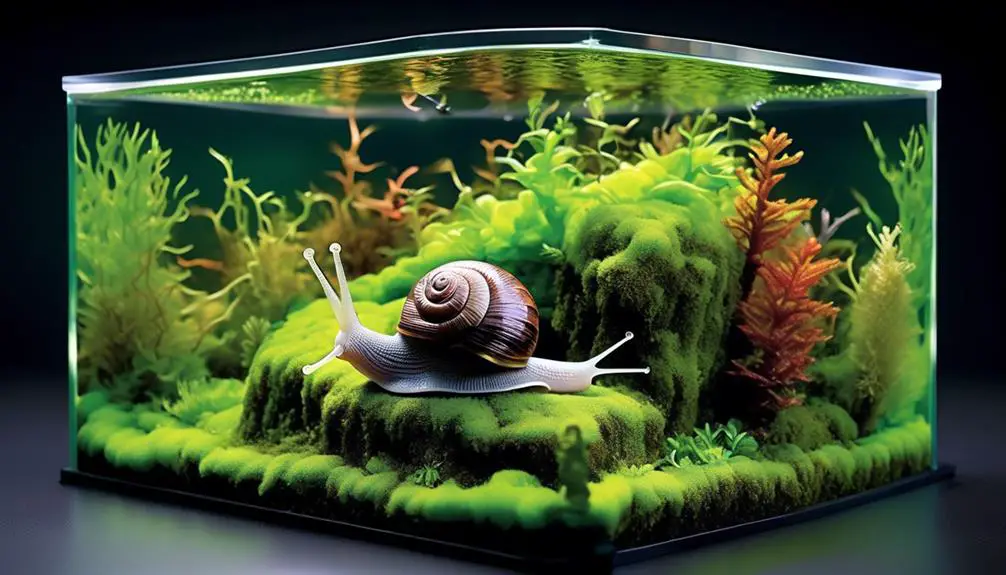
Snails in tanks have a strong affinity for moss, making them true moss-loving tank dwellers. These gastropods are known for their ability to burrow into moss and create moss bedding in their tank. They constantly nibble on the moss, feeding on its nutritious components. In order to support the growth of moss, a moist environment is essential. Snails thrive in such conditions, as it aids in keeping them happy and healthy in their tank.
Observations reveal that snails exhibit a keen interest in moss as a food source. They use their radula, a specialized feeding organ, to scrape off small bits of moss from the surfaces. This behavior isn’t only an effective feeding mechanism but also a way for snails to explore their environment. The moss provides a varied diet for the snails, offering them essential nutrients, including carbohydrates, minerals, and vitamins.
The presence of moss in the tank not only benefits snails nutritionally but also enhances their overall well-being. Moss provides a natural and stimulating environment for the snails, allowing them to engage in natural behaviors such as foraging and burrowing. Additionally, moss creates a soft and comfortable substrate for the snails, mimicking their natural habitat.
Caribou: Moss as Winter Sustenance
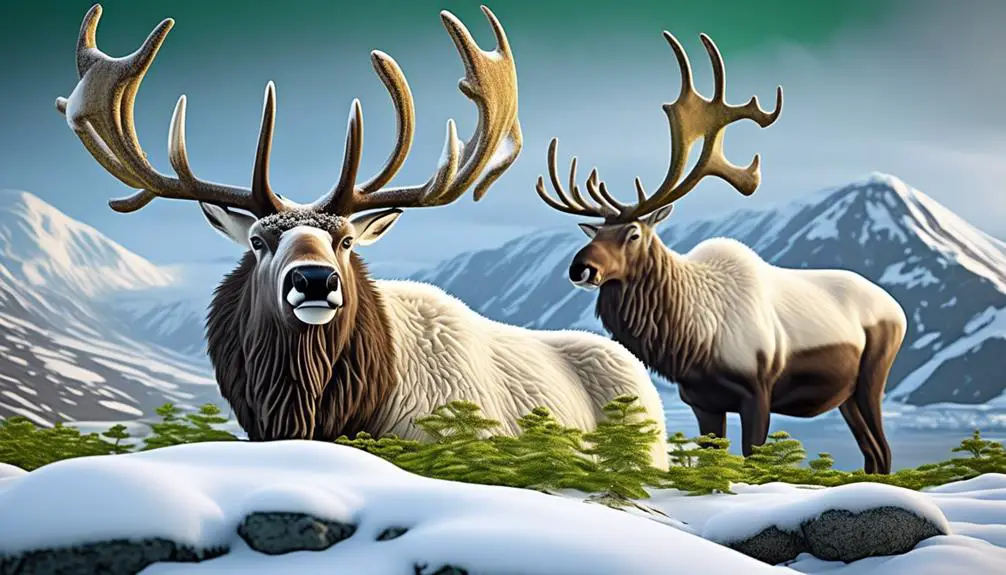
Caribou rely on moss as a vital source of sustenance during the harsh winter months. As North American reindeer native to Arctic regions, these magnificent creatures face limited food availability due to the unforgiving climatic conditions. During winter, when alternative food sources are scarce, caribou turn to moss for their survival.
Moss thrives in the very conditions that challenge other plants, making it an ideal food source for caribou during the winter. With their ability to tolerate extreme temperatures and grow in nutrient-poor environments, mosses become a lifeline for these animals.
The nutritional value of moss is essential for caribou to maintain their energy levels and survive the harsh winter. Moss provides carbohydrates, proteins, and fats that are crucial for their metabolism and body functions. Additionally, mosses contain vitamins and minerals that caribou need to stay healthy during this challenging time.
Caribou have adapted to efficiently consume moss through their unique feeding strategies. They use their specialized jaw structure and dental adaptations to efficiently graze on these plants. The caribou’s digestive system is also well-equipped to extract the maximum nutrients from the moss they consume.
Musk Oxen: Arctic Grazers and Moss Consumers
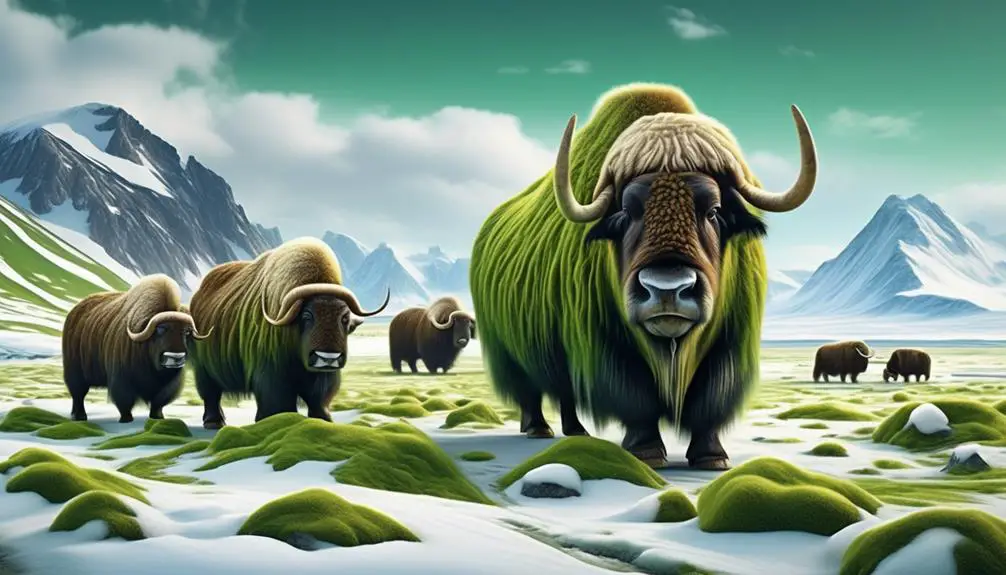
Do musk oxen, unique animals native to the Arctic region, rely on moss as a regular part of their diet?
Musk oxen, with their thick coats and curved horns, are well-adapted to the harsh Arctic environment. These majestic creatures are known for their ability to survive in extreme conditions, including the long, cold winters where food can be scarce. While musk oxen primarily feed on any available vegetation, they do depend on lichens and moss, especially during the winter months when other food sources are limited. Moss forms a regular part of their diet, providing them with necessary nutrition for survival.
Musk oxen are grazers, using their muscular bodies to forage for food across the tundra landscape. They’ve a unique digestive system that allows them to break down and extract nutrients from tough and fibrous plants, including moss. In fact, studies have shown that musk oxen have a preference for certain types of moss, such as reindeer moss, which is abundant in the Arctic region. This type of moss is high in carbohydrates and protein, providing the musk oxen with the energy they need to endure the harsh winter conditions.
Observations of musk oxen in the wild have revealed their grazing habits, as they carefully select patches of moss to feed on. They use their powerful jaws to tear off chunks of moss, which they then chew and swallow. The musk oxen’s digestive system efficiently extracts nutrients from the moss, allowing them to derive sustenance from this important food source.
Amano Shrimps: Moss-Nibbling Aquatic Foragers

Amano shrimps, as moss-nibbling aquatic foragers, play a vital role in the aquatic ecosystem by actively searching for and consuming moss as a source of food. These shrimps, belonging to several species, exhibit a unique feeding behavior where they nibble through moss in search of sustenance. While their primary source of food is algae, they also consume moss, especially in their natural habitats.
In captivity, Amano shrimps are often fed moss balls, which aid in their food consumption. Moss balls provide a convenient way for the shrimps to access and consume moss. The shrimps use their specialized mouthparts to nibble through the moss, extracting nutrients and sustenance as they feed.
The significance of Amano shrimps as moss consumers extends beyond their dietary preferences. By actively foraging for and consuming moss, these shrimps contribute to the control and management of moss growth in aquatic environments. Moss can sometimes overgrow and cause imbalances in the ecosystem, impacting the health and well-being of other aquatic organisms. Amano shrimps help maintain a healthy balance by keeping moss growth in check.
Betta Fish: Moss and the Natural Environment
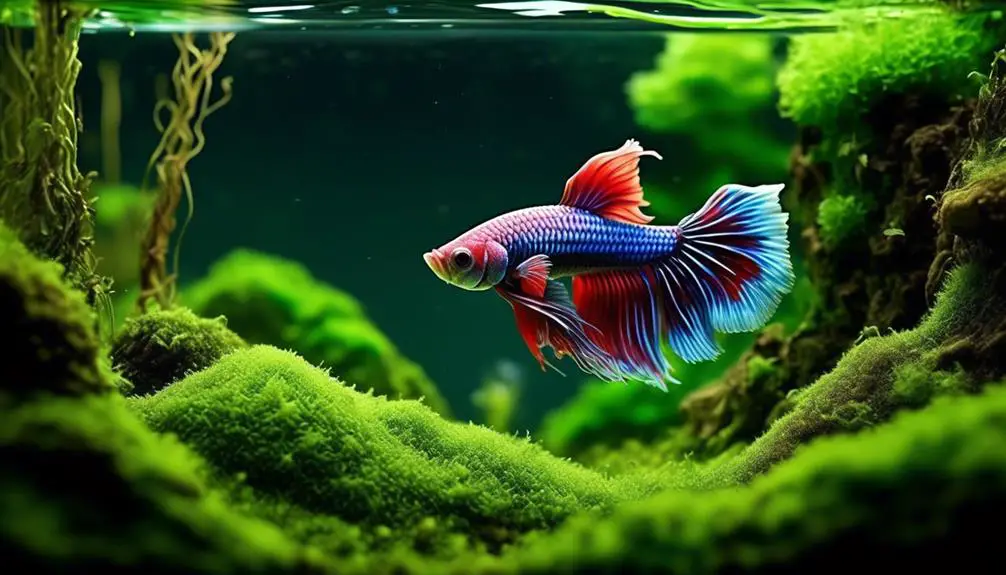
In the natural environment, moss plays a crucial role in creating a favorable habitat for Betta fish. Moss provides a variety of benefits for these carnivorous fish, enhancing their overall well-being. One important advantage of moss is that it serves as a natural food source for Betta fish. In the wild, these fish can find food around Java moss, a common type of moss found in their natural habitat. Including Java moss in their tank can help replicate this natural atmosphere and improve their appetite and health. The table below summarizes the key benefits of moss for Betta fish:
| Moss and Betta Fish | |
|---|---|
| Benefits | Observations |
| Natural food source | Betta fish find food around |
| Java moss in the wild | |
| Improved appetite | Including Java moss |
| improves appetite and health | |
| Favorable habitat | Replicating natural |
| atmosphere helps Betta fish | |
| stay healthy |
Other Animals: Surprising Moss Eaters
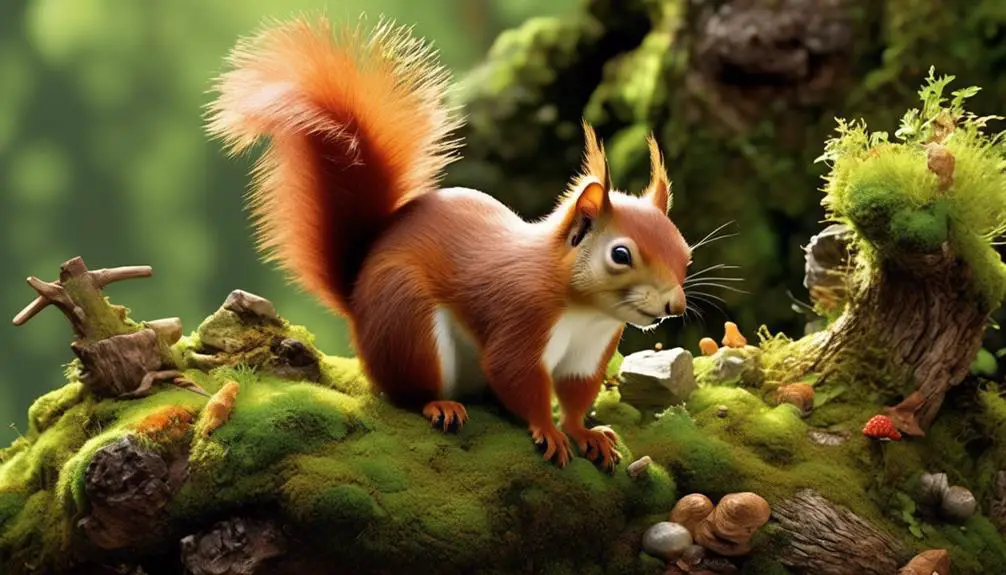
You may be surprised to learn that moss isn’t only consumed by small mammals and aquatic creatures, but also by a variety of insects, birds, and reptiles.
Moss-eating insects, such as certain beetles and caterpillars, can often be found nibbling on moss in search of food or shelter.
Moss-eating birds, such as some species of thrushes and grouse, have been observed pecking at moss to extract insects or to line their nests.
Lastly, moss-eating reptiles, such as certain species of turtles and lizards, have been known to consume moss as part of their diet, possibly for its moisture content or for the nutrients it provides.
Moss-Eating Insects
Moss-Eating Insects, such as beetles and caterpillars, play an important role in the ecosystem by consuming moss and contributing to its decomposition and nutrient cycling.
These insects have developed unique adaptations to feed on moss efficiently. For instance, beetles have specialized mouthparts that allow them to scrape and chew through the moss. Caterpillars, on the other hand, use their strong mandibles to break down the moss into smaller pieces.
As these insects consume moss, they contribute to its decomposition by breaking it down into organic matter. This decomposition process releases nutrients back into the ecosystem, enriching the soil and providing essential elements for other plants and organisms.
Additionally, the presence of moss-eating insects helps regulate moss populations, preventing overgrowth and maintaining a balanced ecosystem.
Moss-Eating Birds
Observing their foraging habits, it becomes apparent that certain bird species demonstrate a surprising inclination for consuming moss. One such species is the Blackbird (Turdus merula), commonly found in North America.
These birds have been observed pecking at patches of moss on trees and rocks, using their sharp beaks to extract the moss from its substrate. They seem to show a preference for certain types of moss, such as Hypnum moss and Polytrichum moss.
The Blackbirds use the moss as a source of hydration, as it retains water and provides a moist environment for the birds to drink from. Additionally, the moss may provide supplementary nutrients to the birds, as it contains trace elements and minerals.
Further research is needed to fully understand the nutritional benefits of moss consumption in birds.
Moss-Eating Reptiles
Several reptile species have been observed consuming moss, displaying an unexpected affinity for this plant material. One such reptile is the Green Iguana (Iguana iguana), a large arboreal lizard found in Central and South America. These reptiles have been observed grazing on moss growing on tree branches, as well as on the ground. They use their sharp teeth to scrape off the moss and then chew it, possibly deriving some nutritional benefits from it.
Another reptile that consumes moss is the Russian Tortoise (Agrionemys horsfieldii). These tortoises are herbivorous and feed on a variety of plant material, including moss. They use their strong beak-like mouthparts to break down the moss and extract nutrients from it.
The reasons behind these reptiles’ affinity for moss are still not fully understood, but it’s possible that they find it palatable and a good source of nutrition in their natural habitats. Further research is needed to explore the role of moss in the diet of these reptiles and its potential benefits.

Erzsebet Frey (Eli Frey) is an ecologist and online entrepreneur with a Master of Science in Ecology from the University of Belgrade. Originally from Serbia, she has lived in Sri Lanka since 2017. Eli has worked internationally in countries like Oman, Brazil, Germany, and Sri Lanka. In 2018, she expanded into SEO and blogging, completing courses from UC Davis and Edinburgh. Eli has founded multiple websites focused on biology, ecology, environmental science, sustainable and simple living, and outdoor activities. She enjoys creating nature and simple living videos on YouTube and participates in speleology, diving, and hiking.
🌿 Explore the Wild Side!
Discover eBooks, guides, templates and stylish wildlife-themed T-shirts, notebooks, scrunchies, bandanas, and tote bags. Perfect for nature lovers and wildlife enthusiasts!
Visit My Shop →